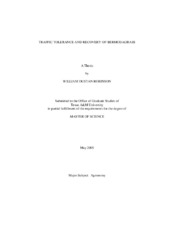| dc.description.abstract | Bermudagrass is the predominant turfgrass used for athletic fields in the southern
United States. Numerous bermudagrass cultivars are utilized for sports field use. Two
frequent variations in management among facilities include mowing and nitrogen
fertility regimes. Research is needed to determine the influence of bermudagrass
cultivar, mowing regime, and nitrogen fertility on traffic tolerance. Research conducted
at Texas A&M Univeristy studied the traffic tolerance of Tifsport, GN-1, Princess, and
NuMex Sahara bermudagrasses. These grasses were mowed once weekly at 3.80 cm
and three times weekly at 1.90 cm and fertilized with 146, 292, 585, or 1171 kg ha-1 yr-1.
Digital images were taken before and after simulated traffic to provide a quantitative
value for percent coverage. Images were analyzed for percent green canopy coverage
using Sigma Scan Pro. The number of green pixels was divided by the total image
pixels a yielding a percent coverage value. Shoot density, visual quality, tissue water
content, and tissue dry mass values were taken monthly. Percent tissue nitrogen was
taken for three months. Analysis of digital images revealed variability in traffic injury
tolerance between varieties. Tifsport, GN-1, and Princess maintained higher percent
coverage than NuMex Sahara. GN-1, Princess, and Tifsport were able to tolerate traffic
but did not maintain acceptable quality. Lower and more frequent mowing increased
shoot density and visual quality for all grasses. Increased nitrogen fertility levelsincreased tissue succulence and tissue dry mass but did not affect the traffic tolerance of
any variety. Increasing nitrogen fertility above 585 kg ha-1 yr-1 showed no benefit other
than increasing visual color. This research provides a guide for managers to make
informed decisions on cultivar selection and management practices under traffic
conditions. | en |


